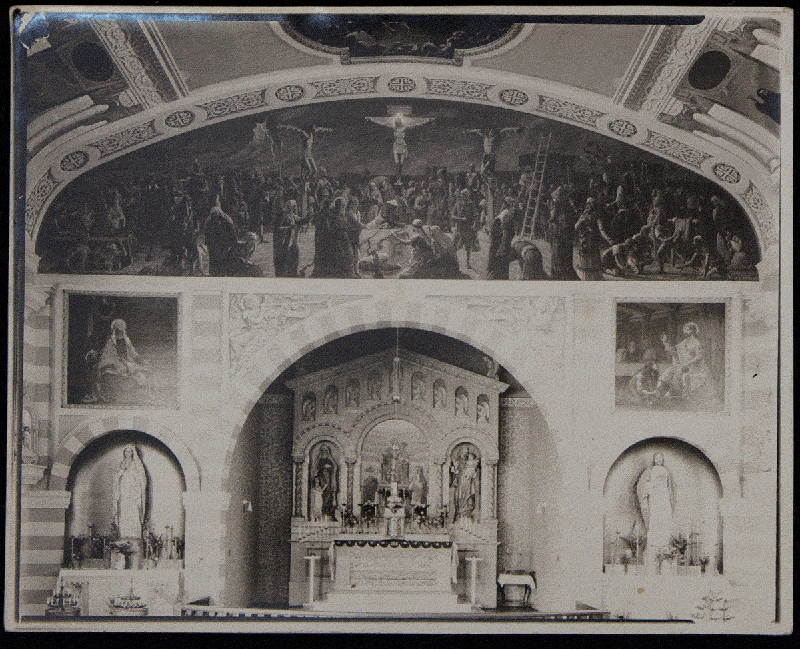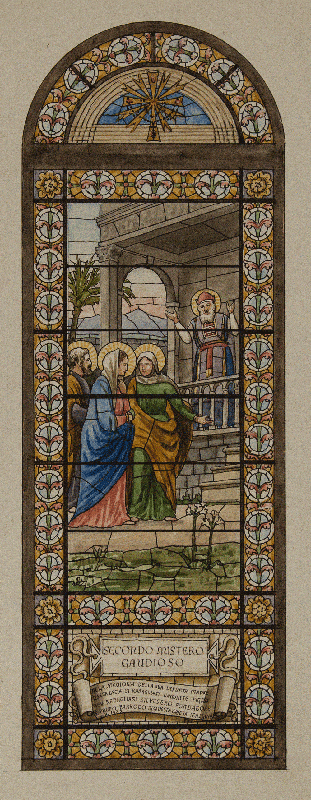Our Lady of the Rosary
The Catholic Church of Our Lady of the Rosary stands at the intersection of State and Date Streets in San Diego's vibrant Little Italy.
In the last century, when Italian immigrants came to the area, they wanted a church to provide a place for worship. They also wanted to knit the community together by making the church a symbol of pride in their heritage. The immigrants, many of whom were fishermen, pooled their monies together to have the church built. "The Church of the Fishermen" was, and is to this day, staffed by Barnabite priests from Italy.
The priests and the community wanted to recall the beauty of the art from their native land, so they located Fausto Tasca to design all the interior paintings, windows and sculpture for the church. Tasca, who was trained in Italy, was very familiar with Italianate styles of decoration.
Our Lady of the Rosary was a massive project which monopolized several years of Fausto Tasca's career. Because of the scope of the project, he called upon his friend, Carlo Romanelli, to assist in providing the altar sculptures of the Blessed Virgin and Saint Joseph. Tasca applied the paint to these sculptures.
In addition to two huge murals, the "Crucifixion" and the "Last Judgement," Tasca created numerous other paintings depicting scenes from the "Mysteries of the Rosary." He also designed the stained–glass windows for the church.
Additional information about Fausto Tasca’s career can be found at www.fasutotasca.com

ALTAR AND CRUCIFIXION MURAL. Photograph of the main altar and nave decoration, including the huge "Crucifixion" mural. This photo shows the church interior shortly after Fausto Tasca completed his extensive project. His careful design of every detail of the altar can be seen in this image.
Original photograph by Fitch Photography of San Diego.

NAVE. This image shows the detailed decoration of the church interior as Fausto Tasca envisioned it. The ceiling medallions were painted in Tasca's Los Angeles studio on canvas panels. He transported the paintings by train to San Diego, where he installed them individually on the ceiling.
Original photograph by Fitch Photography, San Diego.

OUR LADY OF THE ROSARY. Fausto Tasca's interpretation of Our Lady of the Rosary was created to hang near the altar at Our Lady of the Rosary Church.

CONCEPT SKETCH. Fausto Tasca created this watercolor sketch to present his concept for the stained–glass windows. Tasca had the stained–glass windows created to his specifications. After they were installed in the church, he hand–painted the faces and all other details into each window.

PAINTING THE WINDOWS. Fausto Tasca painted the faces and all other details onto the stained–glass windows. This publicity photo, taken by a local newspaper photographer, shows Tasca at work on the windows.

PAINTING THE MURALS. Fausto Tasca created all the ceiling medallions and both huge murals at his Los Angeles studio. All these paintings were executed in oil on canvas. Once the paintings were complete and had dried sufficiently to be transported, Fausto hand–carried the canvases to Our Lady of the Rosary in San Diego.
Fausto's son recounted that the family did not have the means to own an automobile. When it was necessary to transport a sketch or drawing to the church, Fausto rode the train. He rolled the large canvases and carried them as his "hand baggage."